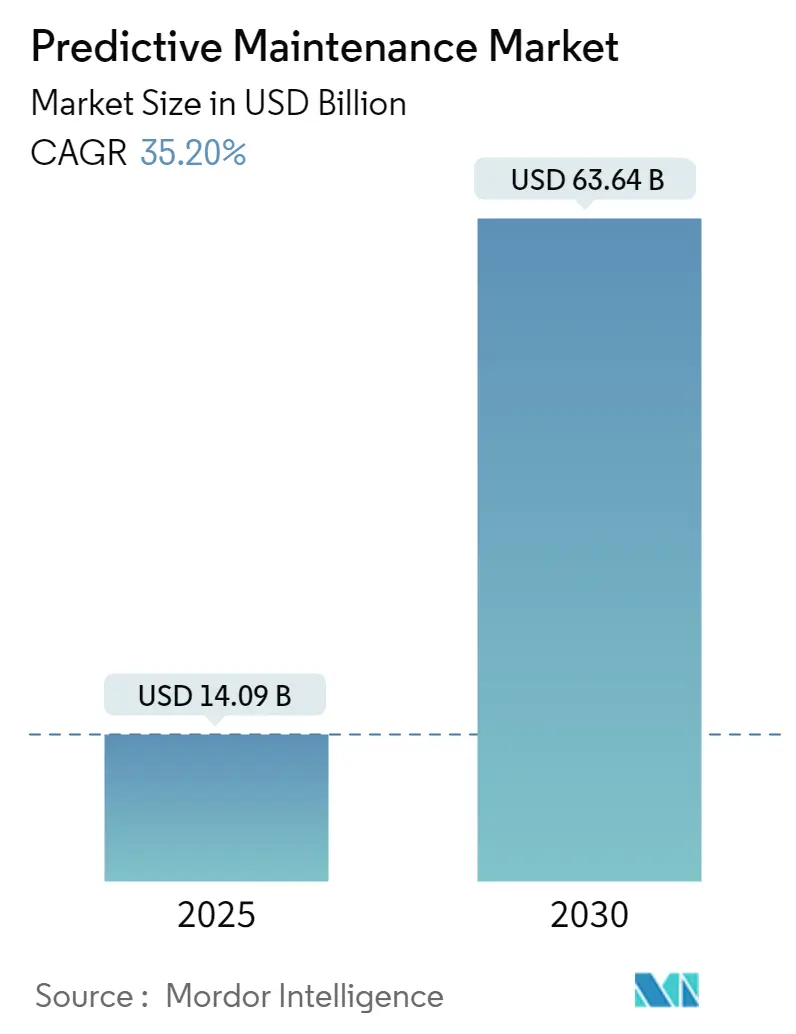
| Study Period | 2019 - 2030 |
| Market Size (2025) | USD 14.09 Billion |
| Market Size (2030) | USD 63.64 Billion |
| CAGR (2025 - 2030) | 35.20 % |
| Fastest Growing Market | North America |
| Largest Market | North America |
| Market Concentration | Low |
Major Players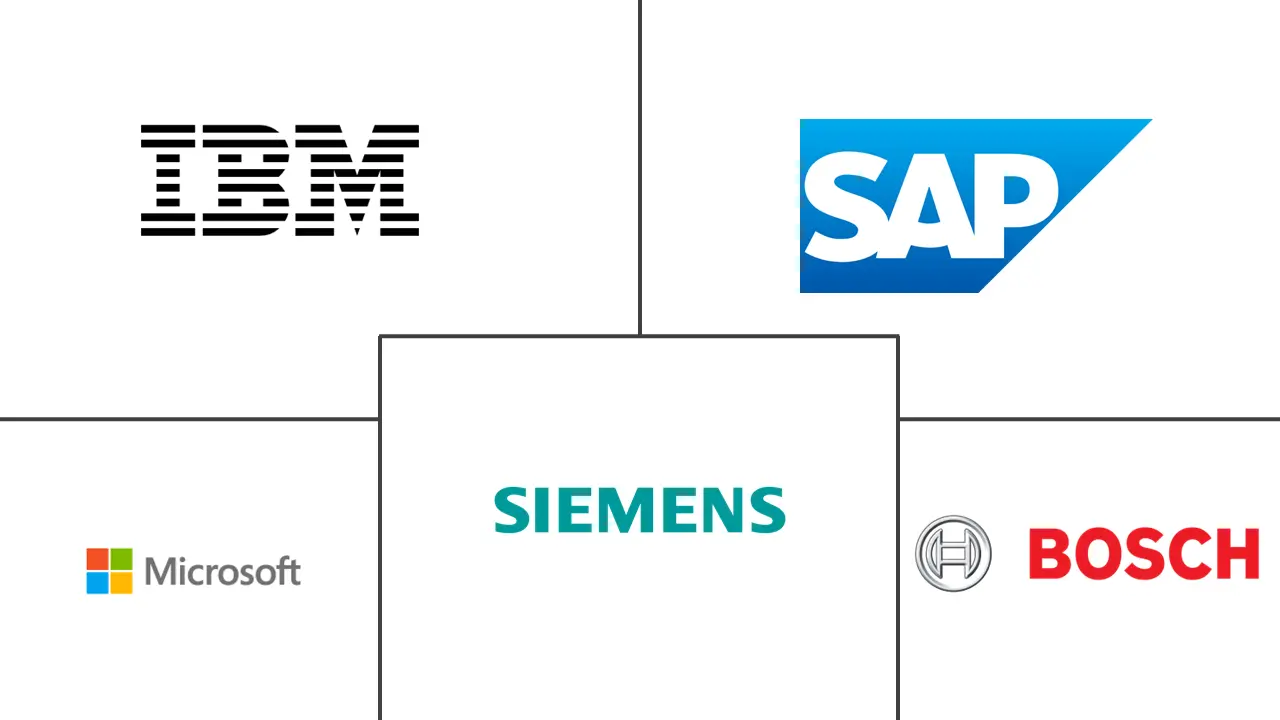
*Disclaimer: Major Players sorted in no particular order |
Predictive Maintenance Market Analysis
The Predictive Maintenance Market size is estimated at USD 14.09 billion in 2025, and is expected to reach USD 63.64 billion by 2030, at a CAGR of 35.2% during the forecast period (2025-2030).
- The rising adoption of cloud computing, AI, and machine learning drives the predictive maintenance market. Cloud computing streamlines access to predictive maintenance tools and data, empowering organizations to adopt solutions without significant upfront costs. Technicians leverage mobile technology to engage with predictive maintenance systems, ensuring they receive updates and can manage tasks while moving.
- Advancements in artificial intelligence (AI) and machine learning (ML) are rapidly transforming the predictive maintenance market. These technologies enable organizations across various industries to anticipate equipment failures and optimize maintenance schedules. AI significantly enhances the efficiency of predictive maintenance by leveraging advanced data analytics, machine learning, and real-time monitoring to predict equipment failures and optimize maintenance schedules. AI systems analyze vast amounts of data from equipment sensors, operational metrics, and historical performance records. This analysis helps identify patterns that may indicate potential failures.
- Key market vendors are focusing on AI integration in predictive maintenance owing to growing consumer demand for these technologies. For instance, in July 2024, Guidewheel unveiled its latest offering, Scout. This innovative product is designed to empower manufacturers in predictive maintenance requirements and identifying early warning signs of potential issues, thereby averting machine downtime or failure. Leveraging advanced AI capabilities, Scout perpetually scrutinizes machine performance data, pinpointing anomalies and promptly notifying teams of critical concerns.
- AI-driven predictive maintenance offers a compelling advantage: a significant reduction in unplanned downtime. With the capability to accurately forecast equipment failures, businesses can time their maintenance activities to minimize operational disruptions.
- Many industries face challenges with aging equipment and infrastructure. Implementing predictive maintenance extends the lifespan of these assets, ensuring sustained productivity. Disruptions in global supply chains highlight the need for reliable operations. Predictive maintenance mitigates risks by keeping critical machinery operational.
- Small and medium-sized enterprises often face substantial upfront costs when adopting predictive maintenance technologies, such as IoT devices and analytics software. Also, integrating data from various sources, such as sensors, machines, and legacy systems, often proves complex and challenging, and poor data quality can result in inaccurate predictions.
- During economic downturns, companies often tighten their budgets, leading to delays or reductions in investments in predictive maintenance technologies and solutions. Organizations tend to prioritize short-term cost-saving measures over long-term investments in predictive maintenance, which fosters reliance on reactive maintenance strategies. Furthermore, economic uncertainty can curtail capital expenditures on new machinery, subsequently affecting the demand for predictive maintenance services associated with these new installations.
Predictive Maintenance Market Trends
Automotive and Transportation is Expected to Witness Remarkable Growth
- As companies in the automotive and transportation sectors strive for greater efficiency, cost reduction, and heightened safety, predictive maintenance is gaining paramount importance. By integrating IoT sensors, vehicles can now be monitored in real-time, facilitating an ongoing evaluation of their health. Moreover, the advent of smart cities and interconnected roadways bolsters these efforts by enhancing vehicle communication, thereby reinforcing predictive maintenance strategies.
- With the rise of electric and autonomous vehicles, predictive maintenance strategies are adapting to cater to diverse systems and components. As per the International Energy Agency (IEA), in 2023, global registrations of new electric cars reached nearly 14 million, pushing the total on the roads to 40 million. The 2023 sales marked a 3.5 million increase from 2022, translating to a robust 35% year-on-year growth. In 2023, China held 16.1 million battery electric vehicle (BEV) stock in 2023, which is more than 10 million compared to Europe in the same year. In electric vehicles, keeping a close watch on battery performance and health is paramount, resulting in tailored predictive maintenance requirements.
- In response to stricter emissions regulations, companies are turning to predictive maintenance to ensure compliance and reduce their environmental footprint. This approach not only enhances fuel efficiency, supporting sustainability objectives, but also aids companies in cutting operational costs by averting expensive breakdowns and minimizing downtime.
- In response to intensifying competition, companies in the automotive and transportation sectors are increasingly turning to predictive maintenance to enhance service levels and boost operational efficiency.
- In January 2024, Infineon Technologies AG and Aurora Labs partnered to enhance predictive maintenance solutions in the automotive sector, elevating driver safety. The duo has introduced a suite of AI-driven solutions aimed at bolstering the reliability and safety of vital automotive components, such as steering systems, brakes, and airbags. By integrating Aurora Labs' award-winning Line-of-Code Intelligence (LOCI) AI technology with Infineon's 32-bit TriCore AURIX TC4x microcontroller family, the collaboration empowers automotive manufacturers to deliver vehicles that are not only safer and more reliable but also maintain peak performance throughout their lifespan. Such developments in the industry are expected to drive market growth in coming years.
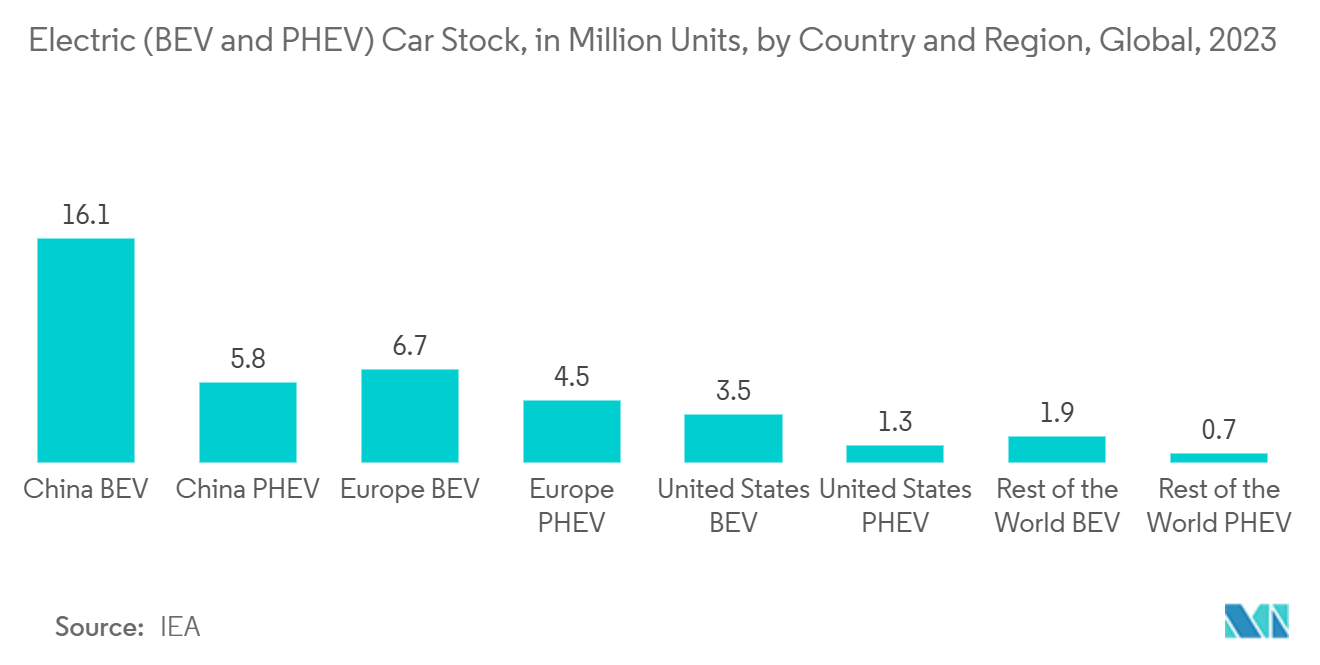
North America to Hold Significant Market Share
- North America is channeling substantial investments into emerging technologies bolstering predictive maintenance initiatives. These investments encompass funding for R&D in AI, IoT, and data analytics, all aimed at refining predictive maintenance systems.
- North America is witnessing a significant acceleration in cloud computing adoption across multiple sectors. This surge is primarily fueled by the rapid expansion of cloud services, the allure of cost efficiency, the imperative of data security and compliance, and the benefits of scalability and flexibility. Organizations are increasingly focusing on the adoption of cloud-based predictive maintenance solutions. The transition to cloud-based predictive maintenance solutions equips organizations with scalable alternatives, reducing infrastructure costs and enhancing data accessibility.
- Technological advancements, a push to minimize downtime and costs, a rise in industrial applications, and the need for regulatory compliance are propelling the North American predictive maintenance market toward significant growth. As these trends gain traction, predictive maintenance is set to become even more crucial in optimizing operations across diverse sectors.
- In North America's industrial sector, the adoption of automation, robotics, and Industry 4.0 practices is revolutionizing manufacturing processes, leading to heightened efficiency and productivity. Central to these Industry 4.0 initiatives is predictive maintenance, leveraging interconnected systems to bolster operational enhancements.
- By proactively addressing maintenance needs, energy companies can extend the lifespan of their assets, leading to reduced capital expenditures on replacements, thus predictive maintenance solutions gaining popularity in the energy sector. In 2023, the U.S. achieved a historic milestone by installing an unprecedented 31 gigawatts (GW) solar energy capacity. This achievement represents a notable 55% increase from 2022 and significantly eclipses the previous record set in 2021. The Solar Energy Industries Association underscores this achievement, noting that this capacity can meet roughly 5% of the nation's electricity demand. Such increased solar energy capacity further creates significant demand for predictive maintenance solutions to prevent outages and improve reliability.
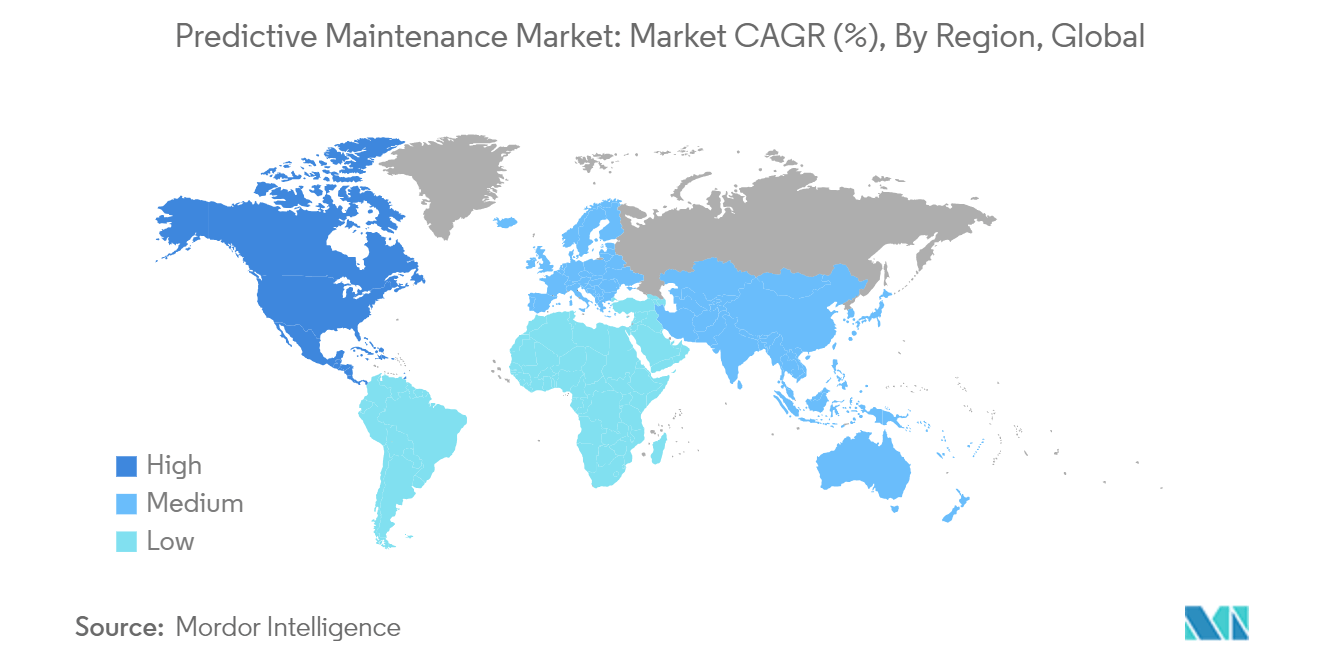
Predictive Maintenance Industry Overview
The predictive maintenance market is highly fragmented, with global and local conglomerates and specialized players operating across various segments. While several large multinational companies dominate specific high-value segments, numerous regional and niche players contribute to the overall competition, making the market highly diverse. This fragmentation is driven by the demand for predictive maintenance market across a wide range of end-user verticals, allowing both large and small companies to coexist and thrive in the market.
Leading companies in the predictive maintenance market include IBM Corporation, SAP SE, Siemens AG, Microsoft Corporation, General Electric Company, Robert Bosch GmbH, ABB Ltd., Schneider Electric SE, Honeywell International Inc., Rockwell Automation, and Emerson Electric Co. These companies have established strong brand recognition and extensive global operations, enabling them to command significant market share. Their strengths lie in innovation, broad product portfolios, and strong distribution networks. These leaders often engage in strategic acquisitions and partnerships to maintain their competitive edge and expand their market reach.
To succeed in the predictive maintenance market, companies must prioritize innovation, as demand from major industries such as healthcare, automotive, industrial, telecommunications, and others is accelerating. In recent years, significant technological advancements have transformed the laser-cutting machine market. Companies that invest in emerging markets and adapt their offerings to regional needs are likely to gain a competitive advantage in this fragmented market.
Predictive Maintenance Market Leaders
-
IBM Corporation
-
SAP SE
-
Siemens AG
-
Microsoft Corporation
-
Robert Bosch GmbH
- *Disclaimer: Major Players sorted in no particular order
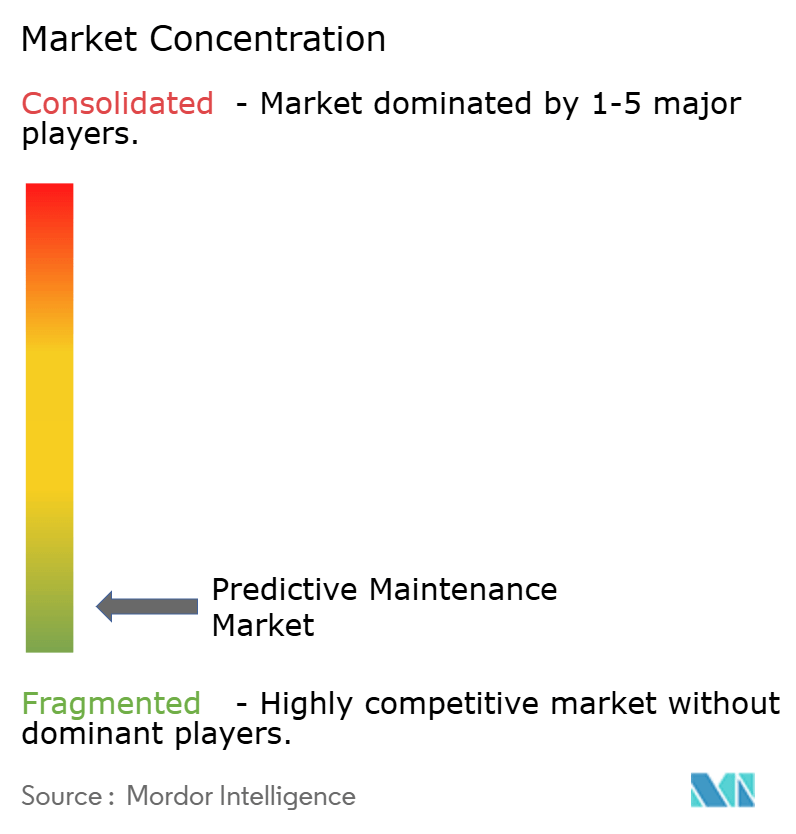
Predictive Maintenance Market News
- June 2024: Hitachi and Microsoft entered into a strategic partnership to propel business and social innovation through Generative AI. This three-year strategic alliance, projected to be worth several billion dollars, aims to craft pioneering industry solutions that yield transformative results for both businesses and society. In collaboration with Microsoft, Hitachi’s Generative AI Center*3 will harness tools like Copilot for Microsoft 365 and GitHub Copilot to boost operational efficiency and streamline application development within the Hitachi Group. Meanwhile, Hitachi Rail is leveraging GenAI for predictive maintenance, leading to enhanced equipment monitoring and improved forecast accuracy. Such a forward-thinking strategy not only averts breakdowns but also elevates service quality, curtails operating costs, and bolsters safety.
- February 2024: Siemens unveiled a new generative artificial intelligence (AI) feature in its predictive maintenance solution, Senseye Predictive Maintenance. This enhancement aims to make predictive maintenance more conversational and intuitive. With this generative AI upgrade, Siemens is set to accelerate and streamline human-machine interactions in predictive maintenance, building upon its established machine-learning capabilities.
Predictive Maintenance Industry Segmentation
Predictive Maintenance employs data analysis and predictive analytics to assess equipment conditions and forecast optimal maintenance timings. Various technologies, such as sensors, IoT devices, machine learning, and data analytics, are employed to monitor equipment health in real time.
The study tracks the revenue accrued through the sale of predictive maintenance solutions by various players across the globe. The study also tracks the key market parameters, underlying growth influencers, and major vendors operating in the industry, which supports the market estimations and growth rates over the forecast period. The study further analyses the overall impact of COVID-19 aftereffects and other macroeconomic factors on the market. The report’s scope encompasses market sizing and forecasts for the various market segments.
The predictive maintenance market is segmented by component (hardware, software (cloud, on-premise), and services), enterprise size (small and medium enterprises, and large enterprises), end-user industry (healthcare, automotive and transportation, industrial, telecommunications, energy and utilities, aerospace and defense, and others), and geography (North America, Europe, Asia Pacific, Middle East & Africa, Latin America). The market sizes and forecasts regarding value (USD) for all the above segments are provided.
| By Component | Hardware | ||
| Software | Cloud | ||
| On-Premise | |||
| Services | |||
| By Enterprise Size | Small and Medium Enterprises | ||
| Large Enterprises | |||
| By End-user Industry | Healthcare | ||
| Automotive and Transportation | |||
| Industrial | |||
| Telecommunications | |||
| Energy and Utilities | |||
| Aerospace and Defense | |||
| Others | |||
| By Geography*** | North America | ||
| Europe | |||
| Asia | |||
| Australia and New Zealand | |||
| Middle East and Africa | |||
| Latin America | |||
Predictive Maintenance Market Research FAQs
How big is the Predictive Maintenance Market?
The Predictive Maintenance Market size is expected to reach USD 14.09 billion in 2025 and grow at a CAGR of 35.20% to reach USD 63.64 billion by 2030.
What is the current Predictive Maintenance Market size?
In 2025, the Predictive Maintenance Market size is expected to reach USD 14.09 billion.
Who are the key players in Predictive Maintenance Market?
IBM Corporation, SAP SE, Siemens AG, Microsoft Corporation and Robert Bosch GmbH are the major companies operating in the Predictive Maintenance Market.
Which is the fastest growing region in Predictive Maintenance Market?
North America is estimated to grow at the highest CAGR over the forecast period (2025-2030).
Which region has the biggest share in Predictive Maintenance Market?
In 2025, the North America accounts for the largest market share in Predictive Maintenance Market.
What years does this Predictive Maintenance Market cover, and what was the market size in 2024?
In 2024, the Predictive Maintenance Market size was estimated at USD 9.13 billion. The report covers the Predictive Maintenance Market historical market size for years: 2019, 2020, 2021, 2022, 2023 and 2024. The report also forecasts the Predictive Maintenance Market size for years: 2025, 2026, 2027, 2028, 2029 and 2030.
Predictive Maintenance Industry Report
Statistics for the 2025 Predictive Maintenance market share, size and revenue growth rate, created by Mordor Intelligence™ Industry Reports. Predictive Maintenance analysis includes a market forecast outlook for 2025 to 2030 and historical overview. Get a sample of this industry analysis as a free report PDF download.




